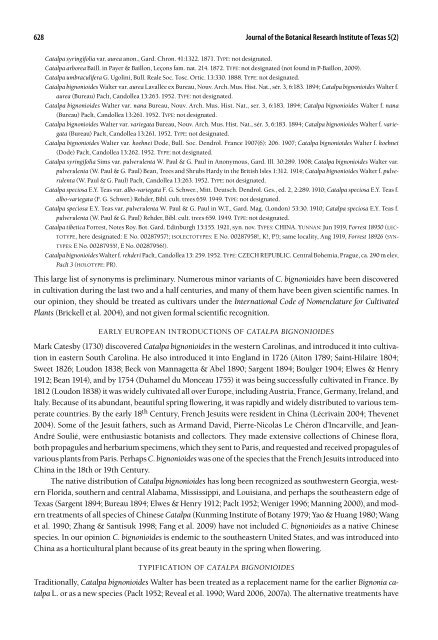J.H. Kirkbride, Jr. R.T. Olsen - Brit
J.H. Kirkbride, Jr. R.T. Olsen - Brit
J.H. Kirkbride, Jr. R.T. Olsen - Brit
You also want an ePaper? Increase the reach of your titles
YUMPU automatically turns print PDFs into web optimized ePapers that Google loves.
628 Journal of the Botanical Research Institute of Texas 5(2)<br />
Catalpa syringifolia var. aurea anon., Gard. Chron. 41:1322. 1871. type: not designated.<br />
Catalpa arborea Baill. in Payer & Baillon, Leçons fam. nat. 214. 1872. type: not designated (not found in P-Baillon, 2009).<br />
Catalpa umbraculifera G. Ugolini, Bull. Reale Soc. Tosc. Ortic. 13:330. 1888. type: not designated.<br />
Catalpa bignonioides Walter var. aurea Lavallée ex Bureau, Nouv. Arch. Mus. Hist. Nat., sér. 3, 6:183. 1894; Catalpa bignonioides Walter f.<br />
aurea (Bureau) Paclt, Candollea 13:263. 1952. type: not designated.<br />
Catalpa bignonioides Walter var. nana Bureau, Nouv. Arch. Mus. Hist. Nat., ser. 3, 6:183. 1894; Catalpa bignonioides Walter f. nana<br />
(Bureau) Paclt, Candollea 13:261. 1952. type: not designated.<br />
Catalpa bignonioides Walter var. variegata Bureau, Nouv. Arch. Mus. Hist. Nat., sér. 3, 6:183. 1894; Catalpa bignonioides Walter f. variegata<br />
(Bureau) Paclt, Candollea 13:261. 1952. type: not designated.<br />
Catalpa bignonioides Walter var. koehnei Dode, Bull. Soc. Dendrol. France 1907(6): 206. 1907; Catalpa bignonioides Walter f. koehnei<br />
(Dode) Paclt, Candollea 13:262. 1952. type: not designated.<br />
Catalpa syringifolia Sims var. pulverulenta W. Paul & G. Paul in Anonymous, Gard. Ill. 30:289. 1908; Catalpa bignonioides Walter var.<br />
pulverulenta (W. Paul & G. Paul) Bean, Trees and Shrubs Hardy in the <strong>Brit</strong>ish Isles 1:312. 1914; Catalpa bignonioides Walter f. pulverulenta<br />
(W. Paul & G. Paul) Paclt, Candollea 13:263. 1952. type: not designated.<br />
Catalpa speciosa E.Y. Teas var. albo-variegata F. G. Schwer., Mitt. Deutsch. Dendrol. Ges., ed. 2, 2:289. 1910; Catalpa speciosa E.Y. Teas f.<br />
albo-variegata (F. G. Schwer.) Rehder, Bibl. cult. trees 659. 1949. type: not designated.<br />
Catalpa speciosa E.Y. Teas var. pulverulenta W. Paul & G. Paul in W.T., Gard. Mag. (London) 53:30. 1910; Catalpa speciosa E.Y. Teas f.<br />
pulverulenta (W. Paul & G. Paul) Rehder, Bibl. cult. trees 659. 1949. type: not designated.<br />
Catalpa tibetica Forrest, Notes Roy. Bot. Gard. Edinburgh 13:155. 1921, syn. nov. types: CHINA. yunnan: Jun 1919, Forrest 18950 (lectotype,<br />
here designated: E No. 00287957!; isolectotypes: E No. 00287958!, K!, P!); same locality, Aug 1919, Forrest 18926 (syntypes:<br />
E No. 00287955!, E No. 00287956!).<br />
Catalpa bignonioides Walter f. rehderi Paclt, Candollea 13: 259. 1952. type: CZECH REPUBLIC. Central Bohemia, Prague, ca. 290 m elev,<br />
Paclt 3 (holotype: PR).<br />
This large list of synonyms is preliminary. Numerous minor variants of C. bignonioides have been discovered<br />
in cultivation during the last two and a half centuries, and many of them have been given scientific names. In<br />
our opinion, they should be treated as cultivars under the International Code of Nomenclature for Cultivated<br />
Plants (Brickell et al. 2004), and not given formal scientific recognition.<br />
early european introductions of catalpa bignonioides<br />
Mark Catesby (1730) discovered Catalpa bignonioides in the western Carolinas, and introduced it into cultivation<br />
in eastern South Carolina. He also introduced it into England in 1726 (Aiton 1789; Saint-Hilaire 1804;<br />
Sweet 1826; Loudon 1838; Beck von Mannagetta & Abel 1890; Sargent 1894; Boulger 1904; Elwes & Henry<br />
1912; Bean 1914), and by 1754 (Duhamel du Monceau 1755) it was being successfully cultivated in France. By<br />
1812 (Loudon 1838) it was widely cultivated all over Europe, including Austria, France, Germany, Ireland, and<br />
Italy. Because of its abundant, beautiful spring flowering, it was rapidly and widely distributed to various temperate<br />
countries. By the early 18 th Century, French Jesuits were resident in China (Lécrivain 2004; Thevenet<br />
2004). Some of the Jesuit fathers, such as Armand David, Pierre-Nicolas Le Chéron d’Incarville, and Jean-<br />
André Soulié, were enthusiastic botanists and collectors. They made extensive collections of Chinese flora,<br />
both propagules and herbarium specimens, which they sent to Paris, and requested and received propagules of<br />
various plants from Paris. Perhaps C. bignonioides was one of the species that the French Jesuits introduced into<br />
China in the 18th or 19th Century.<br />
The native distribution of Catalpa bignonioides has long been recognized as southwestern Georgia, western<br />
Florida, southern and central Alabama, Mississippi, and Louisiana, and perhaps the southeastern edge of<br />
Texas (Sargent 1894; Bureau 1894; Elwes & Henry 1912; Paclt 1952; Weniger 1996; Manning 2000), and modern<br />
treatments of all species of Chinese Catalpa (Kunming Institute of Botany 1979; Yao & Huang 1980; Wang<br />
et al. 1990; Zhang & Santisuk 1998; Fang et al. 2009) have not included C. bignonioides as a native Chinese<br />
species. In our opinion C. bignonioides is endemic to the southeastern United States, and was introduced into<br />
China as a horticultural plant because of its great beauty in the spring when flowering.<br />
typification of catalpa bignonioides<br />
Traditionally, Catalpa bignonioides Walter has been treated as a replacement name for the earlier Bignonia catalpa<br />
L. or as a new species (Paclt 1952; Reveal et al. 1990; Ward 2006, 2007a). The alternative treatments have
















